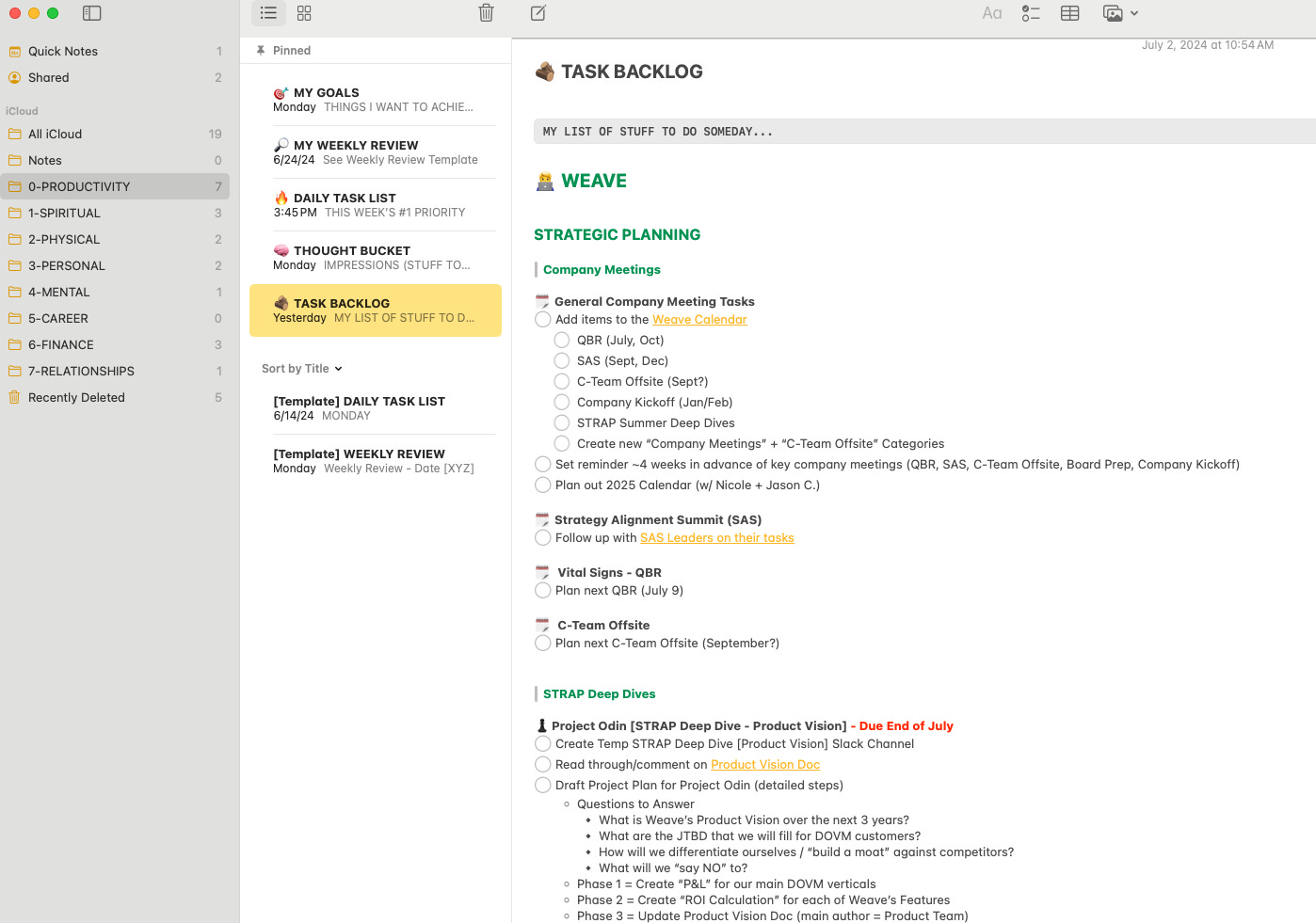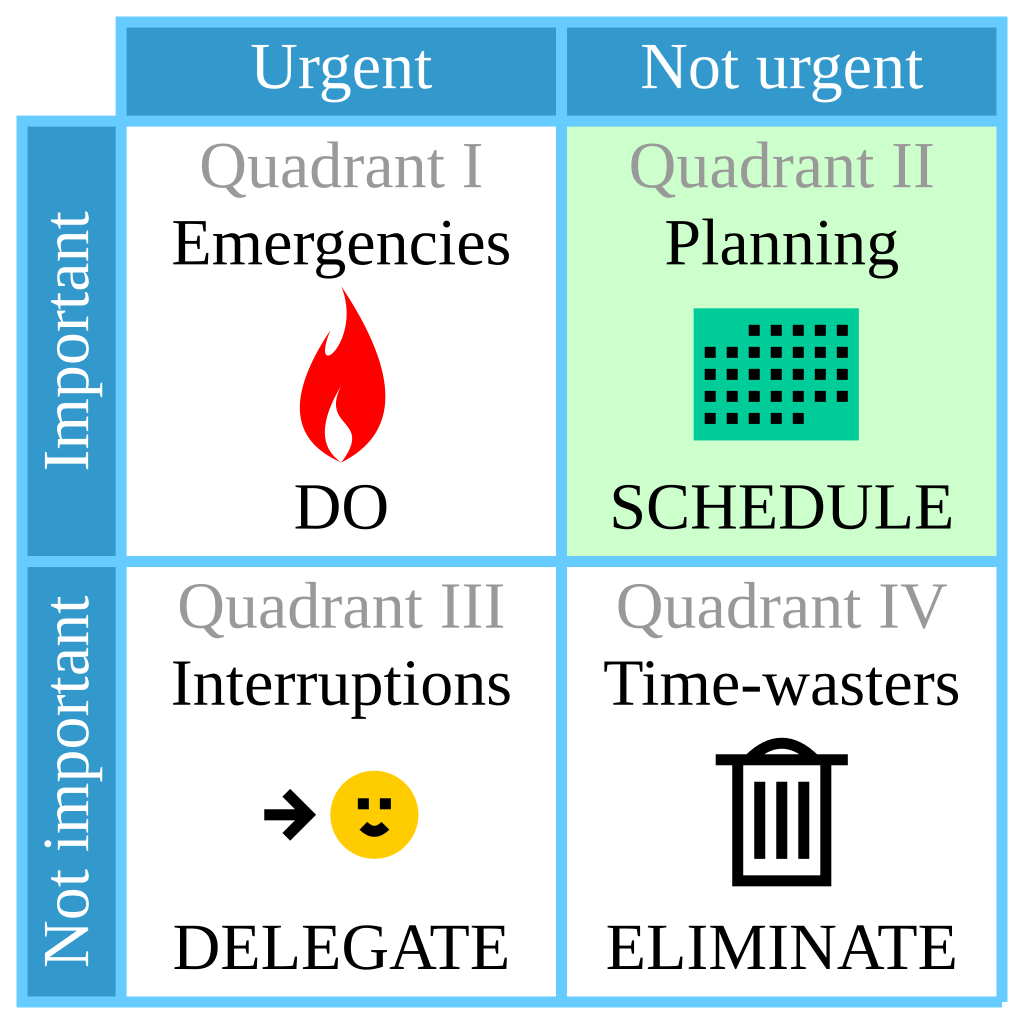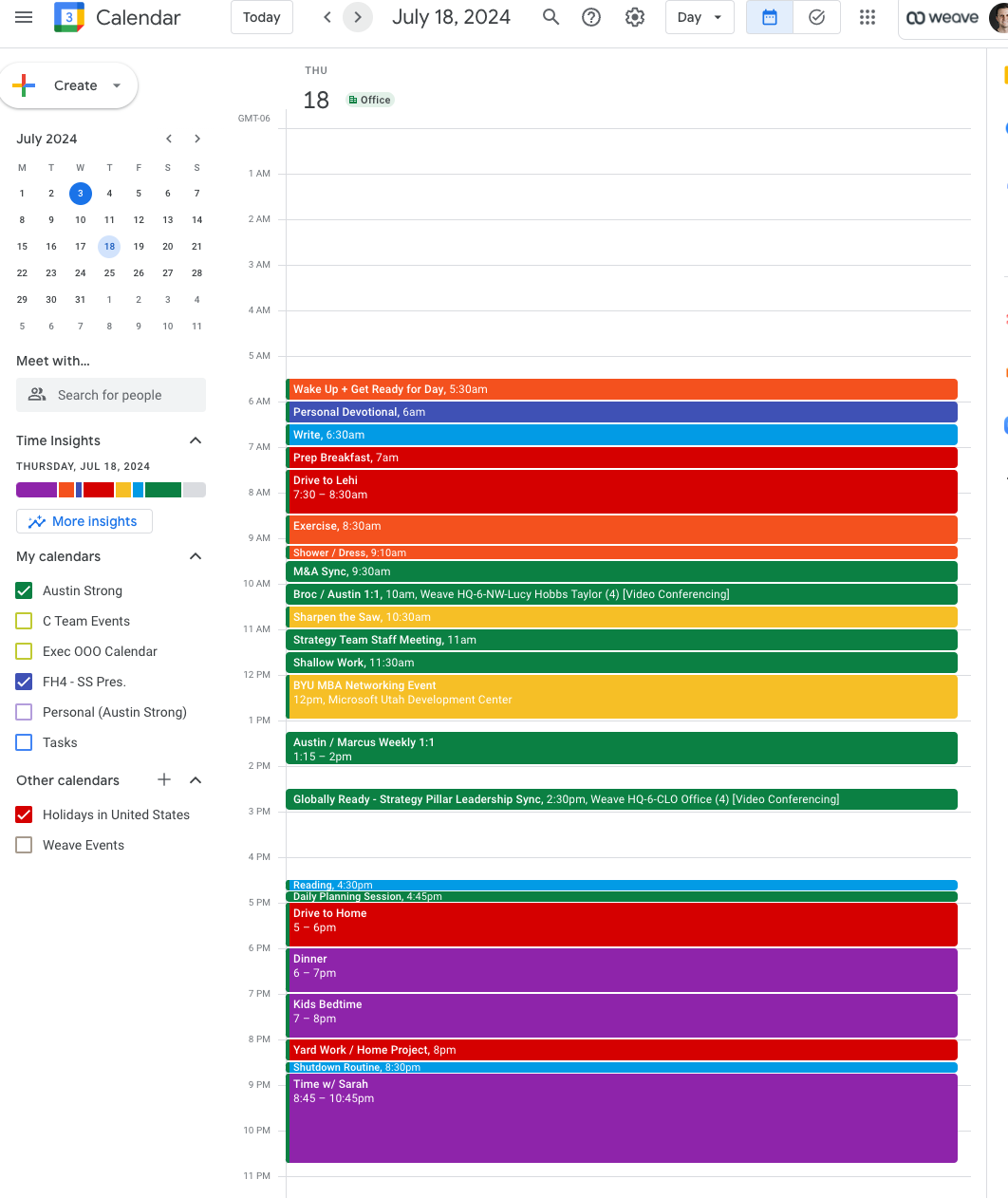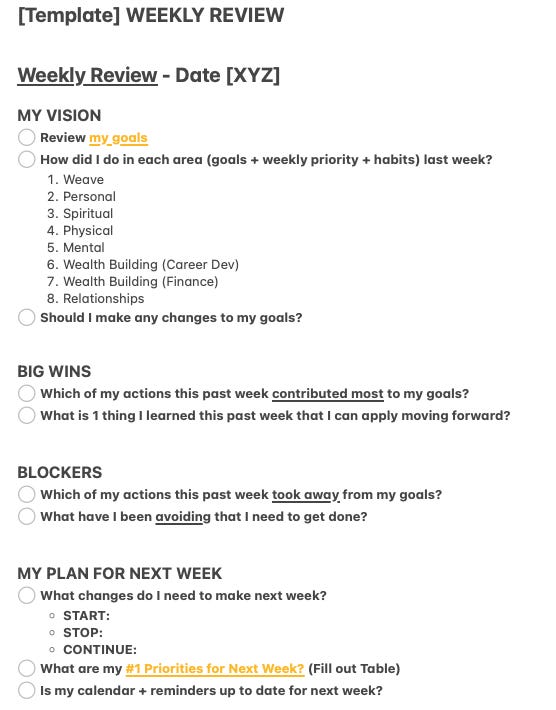Every Friday @ 5:30pm I do the exact same thing.
I open up Apple Notes and read through my “Task Backlog”. My “Task Backlog” is really just my list of items that I need to get done someday. Some things are urgent (ex: that email I need to send next week), others are more long term (ex: taking a personal investing course online).
My Backlog is something I’ve developed over years, and it’s essentially become my 2nd Brain, the place where I store everything that I want to accomplish or need to remember.

After reading through my Backlog, I then lay out what I’m supposed to get done this next week. I generally try to stick with the #1 thing that matters most in each area, and that then makes it into my daily plan.
The trouble is (as you can probably tell from my screenshot above), that my Backlog is HUGE. I think I’m not uncommon in that regard. Most people in the modern age feel overwhelmed by the sheer volume of tasks vying for our attention. Emails flood our inbox, meetings stack up back-to-back, and the to-do list seems to grow by the hour.
The questions I always end up facing at 5:30pm on Friday is this:
“How do I decide what to actually spend time on this week?”
Enter the Eisenhower Matrix, which is perhaps the best framework I’ve found (yet) for prioritizing my personal task list.
What is the Eisenhower Matrix?
The Eisenhower Matrix is a concept developed by Dwight D. Eisenhower, the 5-star general who led the Allied forces during WWII (and later became the 34th president of the United States). Given his high stakes responsibilities, and the veritable flood of requests “requiring” his input, Eisenhower eventually started using this as a tool to make quick decisions under extreme pressure, famously quipping “I have two kinds of problems, the urgent and the important. The urgent are not important, and the important are never urgent.”
The matrix is simple and divides up tasks on your “to-do list” into 4 quadrants based on two criteria: Urgency and Importance. Here is what it looks like:

The Eisenhower Matrix framework
Quadrant I: Urgent and Important
These are tasks that require immediate attention and have significant consequences if not completed promptly. In my life, this basically tends to be things like…
- Crises (ex: a few months ago my daughter broke her arm falling from our playground and had to be taken to the doctor)
- Projects w/ deadlines (ex: slides for the board of directors meeting need to get built by Friday)
- Pressing Problems (ex: a key member of my team gets a competing job offer and we want to keep her on the team)
These are things that you have to do today, which means that they take the highest priority on the Backlog / Daily Task list.
Quadrant II: Not Urgent but Important
Tasks in this quadrant are crucial for long-term success but don’t demand immediate action. These are things that help you grow and progress, but they’re often neglected because they don’t scream for attention.
This includes:
- Strategic planning (ex: figuring out what my team / company should be doing long-term)
- Relationships (ex: spending time with my wife + kids + friends)
- Personal Development (ex: taking time to exercise, read, or write my next Unwritten article)
These are things that if you don’t schedule (and treat those calendar spots as sacred), then they never happen. This is actually the list of tasks that matter most because they are the things that contribute the most to your long term goals. This is generally the stuff that tends to get sacrificed at the altar of the “important” (ex: when i was a management consultant I regularly found myself skipping workouts because I “didn’t have time”, which obviously ended up making me feel overly stressed and less capable of getting things done in the first place)
Quadrant III: Urgent but Not Important
These tasks demand immediate action but have little impact on your long-term goals. Think of interruptions, most emails, and some meetings.
These are tasks that usually come from other people’s priorities (not your own) but you feel pressure to get done. They’re “nice to haves”, but not “critical”.
These are things to delegate to others, or to gracefully say no to.
For example: I’ll often get requests from other departments at Weave to help out with research or projects. I genuinely want to help out, and recognize that the ask may be important for the company (even if it’s not important for my top priorities). I’ll usually find a way to have an intern or another member of my team pitch in (as long as I can take something off their plate to accommodate the request), or I’ll point the person to some helpful resources. This allows me to be helpful without getting distracted from the core things I’m working on.
Quadrant IV: Not Urgent and Not Important
These are the time-wasters—activities that don’t contribute to your goals and aren’t pressing. Social media, scrolling YouTube, and trivial tasks, especially the ones we do to procrastinate doing work that we don’t want to do (I’m particularly guilty of checking ESPN or NBA Twitter when I want to avoid writing an email or work on a presentation)
I’m definitely not against occasionally scrolling the web or reading something interesting, but honestly this is stuff I try to eliminate completely as much as possible (or limit to something really reasonable like 15 mins per day)
Entering the Matrix…
Now that we’ve gotten the framework covered, here is how I put it to work each week to keep myself on track.
- Time Blocking: Each week I review my task list and make sure that I have blocked out time on my calendar for Quadrant II activities. These blocks are non-negotiable sacred times (ex: I don’t skip family dinner unless the world is literally ending).This is what my calendar looks like (the stuff in green / yellow is work related, everything else is a Quadrant II activity that I’ve blocked off). I’ve learned that if something isn’t on my calendar and defended, it doesn’t happen. The key here is that you can’t cheat (ex: blocking off time for exercise, but then moving/canceling it the moment someone asks you for something).

- Daily Planning: Each morning I review my task list + my weekly priorities (my eisenhower matrix) and ensure that my day’s schedule prioritizes Quadrant I and II tasks. For anything in Quadrant III I take 30 mins to schedule out slack messages and/or emails either delegating or politely declining the request.The biggest temptation here is to mis-classify “non-important” tasks (Quadrant III or IV) as “important AND urgent” tasks (Quadrant I). I’ve had to learn through trial and error that most things simply aren’t urgent. And if they’re not urgent, they’re generally not important either.
- Weekly Review: I set aside time each Sunday morning (usually 1 hour) to look back my week and assess how I did at prioritizing Quadrant I and II tasks. It’s surprising how therapeutic this has been. I’ll usually write down what went well, what didn’t go well, and what changes I need to make for the week ahead. I’ve found that this keeps me accountable to myself and makes sure I don’t take my eyes off my long term goals.Here an example of the template I usually go through each Sunday morning:

Conclusion
Ultimately the Eisenhower Matrix is just another tool. Some people I’ve talked to about it find it a little too formal for their tasks. What’s actually more important is the mindset: discerning what truly matters (the “big rocks”) and making time for them. It’s about doing less but better.
That still hasn’t stopped me from building a massive backlog of stuff that I might do someday, but I’ve noticed that I’ve added fewer and fewer things to that list as I get a little older and wiser. More importantly, I’ve stopped feeling that my backlog is something that has to get done. Rather, most things on it are things that I might do someday. And just simply shifting those expectations has made all the difference.


